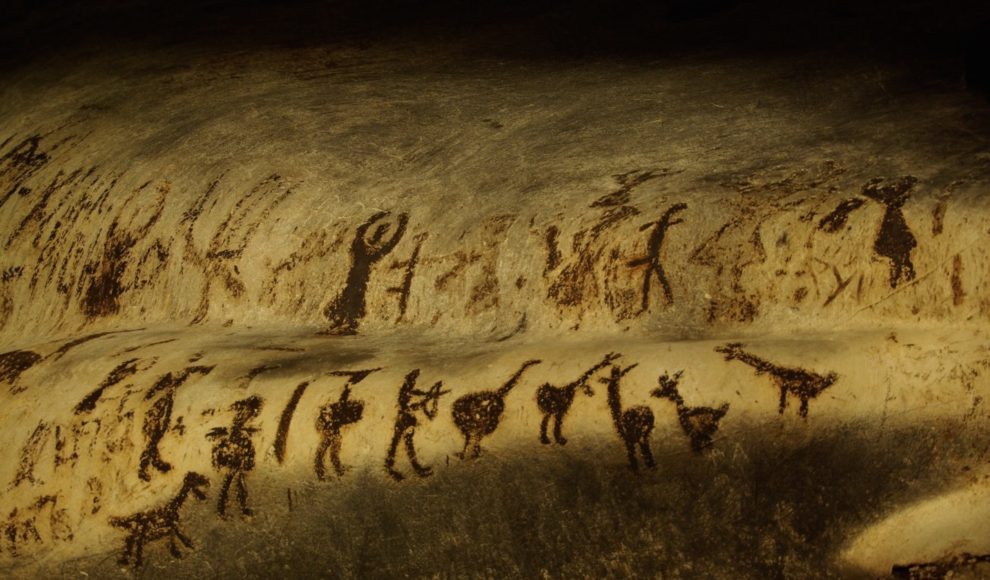Evolutionary biologists take up a range of positions on how important are the various processes that contribute to evolution. Yet the conception of Darwinism that is most vigorously promulgated tends to be a rather simple one. Evolution is portrayed in austere terms as a natural process that hews all the prodigious richness and complexity of life out of chance mutational events and the purposeless forces of nature. There is little room, it might seem, for intelligence in this account.
At least since the middle of the last century, biologists have been deeply skeptical of attempts to attribute any guiding role to intelligent agents. The very notion of “intelligence” in this context smacks of Intelligent Design, the pseudoscientific movement that claims the complex adaptations of living organisms could not have evolved through natural selection and hence (a non sequitur) can only be explained by a divine intelligence. Perhaps the impulse to distance themselves from such accounts has led evolutionary biologists to accentuate the role of chance and the struggle for existence over purposive intelligent behavior. However, there is now considerable interest among biologists in what I would characterize as a directing role for intelligent organisms in evolution (although the term “intelligence” is rarely used).
Don’t get me wrong — I am an atheist and humanist; the intelligence of which I speak derives not from an omniscient power, but from the wholly natural and entirely earthly abilities of living creatures. My focus here is on intelligent information-processing capabilities that have evolved through natural selection. The idea that excites many biologists today is that natural selection has given rise to savvy agents that behave in smart, flexible ways, deploying a bootstrapped intelligence that has fed back on and upgraded evolution itself. In other words, the evolutionary process has evolved — and in a manner that allows species to co-direct their evolution. The easiest place to see this is in our own species.
How Culture Shaped the Human Genome
In the last few years, geneticists have turned their attention to the role of culture in human evolutionary dynamics, and there is now evidence that our cultural activities have shaped the human genome. A turning point in this research was the development of statistical methods for identifying genes that have been favored by natural selection over the past 50,000 years or less. Thus far, somewhere between a few hundred and a couple thousand distinct regions in the human genome have been identified as subject to recent selection. What is particularly striking is that many of these regions appear to have been favored by human cultural practices.
Some compelling examples of how genes and culture have coevolved concern genetic responses to changes in human diet. Human societies vary substantially in their diets, and these differences are mediated by culturally transmitted knowledge. Consider, for instance, the evolution of the human ability to eat starchy foods. Agricultural societies typically consume far more starch in their diets than do hunter-gatherer societies. Cereals, such as wheat, maize and rice, and root or tuber crops like sweet potato, cassava or yams, require extensive cultural knowledge to cultivate effectively. The enzyme responsible for breaking down starch is called amylase. Individuals from populations with high-starch diets have, on average, more copies of the salivary and pancreatic amylase genes (AMY1 and AMY2) that improve the ability to digest starchy foods than do individuals from populations with low-starch diets. That is because their cultural activities and associated diets have generated selection for increased amylase. Interestingly, dogs (which have fed on scraps of human food for millennia) also have a high number of AMY2 copies. A recent study of dogs isolated ten genes that play key roles in starch digestion and fat metabolism and show signals of recent selection.
Another good example of gene–culture coevolution is the evolution of lactose tolerance in adult humans in response to dairy farming. For most humans, the ability to digest lactose disappears in childhood, but in some populations lactase activity, which is necessary for breaking down lactose, persists into adulthood. This adult lactose tolerance is frequent in northern Europeans and in pastoralist populations from Africa and the Middle East, but it is almost completely absent elsewhere. These differences relate to genetic variation near the lactase gene (LCT).There is a strong correlation across cultures between the frequency of lactose tolerance in the population and a history of dairy farming: populations with a long history of consuming milk have high frequencies of tolerance. Diverse lines of evidence have also established that milk-drinking began with early Neolithic humans, who were, as a result, exposed to a strong selection favoring those alleles for lactose tolerance. These societies typically have high LCT frequencies, whereas societies with no dairying traditions generally possess low frequencies. Human populations that have long consumed fermented milk products, such as cheese and yogurt, which have lower levels of lactose, exhibit intermediary frequencies of lactose tolerance. These, and other, findings suggest that the practice of dairy farming arose first, which then favored lactose tolerance, not the other way around.
The signature of selection around the lactase gene is one of the strongest in the human genome, and the onset of the selection has been dated to 5,000–10,000 years ago. Once again, this cultural practice has imposed selection on domesticated animals: milk-protein genes in European cattle breeds correlate to present-day patterns of lactose tolerance in human populations.
Humans have exposed themselves to a wide variety of novel foods through their cultural activities, including through the colonization of new habitats containing different flora and fauna as well as through the domestication of plants and animals and associated agricultural practices. Several nutrition-related genes involved in the metabolism of proteins, carbohydrates, lipids, phosphates, and alcohol all show signals of recent selection. There is also emerging evidence of diet-related selection on the thickness of human teeth enamel, and on bitter-taste receptors on the tongue. It seems that a gene–culture coevolutionary process has shaped the biology of human digestion.
In these and other instances, it is not as if we humans have deliberately imposed selection on ourselves in a conscious effort to enhance our capabilities to metabolize or detoxify the foods we have chosen to consume. But we appear to have imposed a direction on our own evolution nonetheless. What is more, that direction is somewhat predictable. For instance, with knowledge of a population’s agricultural history, we can predict with some degree of accuracy what digestive enzymes it will possess.
Our ancestors were domesticating animals and plants long before they had any theoretical understanding of selective breeding. Thousands of years ago, humans kept wolves, choosing for company the less aggressive among them without recognizing that this selection, iterated over time, would favor profound changes in the wolf phenotype and lead to mild-mannered canine descendants. That the selective breeding imposed by humans on wolves is systematic and directional is illustrated by the fact that many of the same traits — docility, tameness, reductions in tooth size and number, changes in head, face, and brain morphology, floppy ears — have been favored in other domesticated animals. Indeed, the pattern is so striking that researchers speak of a “domestication syndrome” to characterize the suite of phenotypic traits that have evolved in this fashion.
A second domestication syndrome has also been found in plants. Here characteristic features include a loss of head shattering — the process by which plants disperse their seeds upon ripening — and increases in seed size. Again, this evolution has proceeded in a systematic, predictable way. Whether we are talking about cattle, guinea pigs, rice, or wheat, if we know that an organism has been domesticated, we can predict some of the phenotypic traits it will possess. Ultimately, that predictive quality stems from the consistent, reliable, and sustained way in which diverse humans across continents and at different times in history have interacted with the plants and animals they have kept.
Planting crops and tending animals are examples of human “niche construction” — the process by which organisms change their environment in a way that puts new evolutionary pressures on their species and others, triggering the evolution of new adaptive traits. Cultivating plants and domesticating animals are not random activities. They are purposeful, goal-directed practices, reliably performed by populations year after year, sometimes century after century. These activities may be characterized as “intelligent” because they are informed by learned and socially transmitted know-how that has accrued over time. This intelligent behavior appears to have initiated evolutionary episodes in both our own species and other species that share our world. In the process, we have imposed a direction on some evolutionary episodes — a kind of evolutionary bias detectable as predictable, consistent, and sustained responses to selection. Our cultural activities may even affect evolutionary rates. For instance, according to one study, human genetic evolution has accelerated more than a hundredfold over the last 40,000 years.
Dog breeding, hybrid corn manufacture, and dairy farming are not adaptations, in the strict, evolutionary sense. Nor is the knowledge that attends these practices — how to corral horses or cultivate rice, for instance — specified in the human genome. Rather, human agricultural practices are cultural phenomena that exploit some very general adaptations and genetic dispositions that underlie our learning, language, and cognition. To put this in philosophical terms, natural selection underdetermines human niche construction; that is, selection explains the capability but not the content of our behavioral practices — which is why these practices vary across societies.
The fact that natural selection underlies our ability to learn, communicate, and engage in cultural practices does not tell us which populations will engage in agriculture, nor what form these practices will take in a particular population, nor what evolutionary episodes will ensue. A complete causal explanation requires knowledge of human niche-constructing behavior.
The Role of Niche Construction in Evolution
If, as the above reasoning suggests, human niche construction has played an important causal role in some evolutionary events, why is niche construction not widely recognized as an evolutionary process?
Traditional evolutionary explanations have tended to emphasize only those processes that directly change the relative prevalence of particular genes in populations. This approach to evolution is known as the neo-Darwinian or modern synthesis, since it brings together Darwin’s theory of natural selection with the application of Mendel’s theory of genetics to populations of organisms. From this traditional viewpoint, evolution is essentially about how gene variants (alleles) become more or less common in populations. For example, in nineteenth-century England, gene variants responsible for dark coloration in the peppered moth population became more common than the gene variants for light coloration, in part because industrial pollution had blackened the surfaces on which the moths settled, leaving the darker moths less visible to predators. Eventually, partly as a result of this predation, natural selection eliminated the gene for light coloration, leaving only the dark colored moths in the population. This is a classic example of natural selection directly changing the prevalence of genes in a population over time. Other factors that directly influence the prevalence of genes in a population include mutation (which provides the genetic variation that natural selection works on), migration (organisms migrating into a population can bring with them different genes), and genetic drift (changes that result from the random sampling of which organisms reproduce, which can sometimes have dramatic effects in small populations).
However, niche construction does not directly result in changes in the prevalence of genes in populations, and so appreciating its significance calls for biologists to broaden their understanding of what constitutes an evolutionary process. This is precisely what the extended evolutionary synthesis (or EES) does. That is, the EES recognizes additional types of evolutionary processes — including niche construction — that affect evolution in different ways, such as systematically changing the conditions under which natural selection occurs.
Let’s assume a case can be made for recognizing human niche construction as an evolutionary process — on the grounds that it has co-directed evolutionary episodes in predictable ways that could not be fully explained by earlier natural selection alone. Can the same argument be made for the niche construction of worms, birds, or spiders?
After all, animals other than humans generate consistent, reliable, and sustained modifications in their local environments, too, in part because their niche-constructing capabilities have been favored by natural selection. A bird builds a nest, and it immediately creates or modifies selection pressures for the nest to be defended, maintained, regulated, and improved upon in design, and to keep others from stealing it, destroying it, or squatting or dumping eggs in it. A spider spins a web and creates selection pressures that favor sticky webs, oily feet, web-site selection, and anti-predator behavior on webs. Nest building, web spinning, burrow digging, and countless other forms of niche construction generate consistent, reliable, and sustained changes in environmental conditions, often regulating those conditions within precise bounds that are adaptive for the constructor. In other words, animals control certain aspects of their environment, often pushing resources into states that they would not otherwise occupy. In doing so, they, too, impose regularity on some of the selection they encounter, reliably triggering adaptive responses.
Niche construction leaves a kind of signature of environmental change distinct from other environmental changes that are generated by processes independent of the organism. Changes due to niche construction, as opposed to other natural processes, are recognizable because they are reliable, directional, and orderly, as well as often consistent across otherwise unrelated organisms. More than that, the selection pressures generated by niche construction are probabilistically predictable. That is, while predicting exactly what would happen in a given selective scenario may be difficult, researchers are able to make stochastic predictions of particular expected patterns across multiple populations. Research is currently underway to investigate whether this reasoning can help evolutionary biologists to identify traits in which evolutionary responses will be more forecastable, to predict longer-term trends across multiple traits as well as patterns of parallel evolution in isolated populations.
Some, more traditionally minded, evolutionists typically treat humans as a special case, arguing that there are special properties pertaining to our species’ niche construction that stem from our unique capacity for culture. This allows them to defend the position that niche construction is not a general evolutionary process, but rather a trait peculiar to humans that has no significant impact on broader evolutionary forces. Even if these evolutionists were right that niche construction is a directing bias on natural selection only in the case of humans, this would still be extremely important for the study of human evolution, as well as the evolution of domesticated animals and just about any species exposed to anthropogenic environments. In the age of the Anthropocene, such a position comes close to seeing niche construction as a major influence in contemporary evolutionary dynamics. Indeed, humans have been described as “the world’s greatest evolutionary force,” and human-induced evolution increasingly garners scientific attention. However, there are grounds for being suspicious of the claim that human niche construction is unique in this regard.
First, if stable transgenerational culture is thought to underlie the regularities of human niche construction, then we would surely have to accept that other hominins, such as Homo habilis, Homo erectus, and Homo neanderthalensis — which are known to have possessed complex cumulative culture — would also have been capable of co-directing their own and other species’ evolution. If so, we might want to extend the category of niche-constructing species capable of generating a co-directing evolutionary bias to all hominins.
Second, we now know that other animals — including chimpanzees, orangutans, capuchin monkeys, cetaceans such as killer whales and dolphins, as well as many birds — are capable of stable, socially learned and transmitted practices, some of which are documented to have lasted hundreds of years, and perhaps longer. And there is evidence in birds, monkeys, and whales that such socially transmitted behavior generates evolutionary responses. Social learning has been demonstrated experimentally in hundreds of species, including not just vertebrates but also invertebrates such as bees and ants. This potentially widens the scope of a niche-construction bias further.
Third, if the critical factor underlying the ability of niche construction to generate characteristic selective responses is its consistency, reliability, and repeatability, then the emphasis on culture and learning could be misplaced, and any form of plasticity in any organism could potentially instigate this type of response, provided it generates characteristic patterns in ecological variables. There is now extensive data that the plastic responses of diverse organisms are indeed reliable and repeatable.
Choice and Intelligence
There are many ways that species can co-direct evolutionary episodes. Organisms can influence the trajectory of evolution through their active choices — choosing habitats, nest sites, oviposition sites, feeding areas, as well as migrating to more benign regions. This is well-established in the case of sexual selection, where the mate-choice decisions of animals generate evolutionary change, but could apply more generally. Returning to the aforementioned example of industrial melanism, research on moths over the last 50 years has established that this textbook example is more complex than initially depicted, one caveat being the tendency of the moths to choose to settle on backgrounds matching that their color, which dramatically reduces selection. It is widely accepted that animals choose nursery environments, but plants also “choose” microenvironments for their seeds, both by physically positioning them in suitable germination sites (a phenomenon known as “geocarpy”) and through altering the timing of flowering and germination to regulate the seasonal conditions for their descendants.
In most instances, the choices and environmental modifications of individual organisms will have been shaped by earlier natural selection. However, it is an empirical question whether those responses are best regarded as fully determined or underdetermined by prior selection. That will need to be evaluated on a case-by-case basis. Of relevance here are some recent analyses suggesting that organisms not only respond in characteristic ways to particular conditions, but also seem to possess evolved general capabilities to respond flexibly and functionally to whatever conditions they experience — often exhibiting extensive innovation in the process. These capabilities are known as “exploratory processes” or “adaptability.”
Adaptability results in part from a sort of Darwinian evolution occurring within every organism as it develops, grows, senses its environment, and adapts to suit its current circumstances. This is apparent in the immune system, nervous system, and behavioral systems (through learning), which are all constantly adjusting and improving in response to challenges faced by the organism. Computer simulations, for instance of gene regulatory networks, also point to adaptability in the organism’s growth and development, revealing how developmental systems can respond intelligently to new environmental conditions by generating phenotypic variation that is functional and adaptive. In such cases, we can once again regard the plastic responses of organisms as directed yet underdetermined by prior selection. In sum, it remains a plausible hypothesis that the selective bias generated by niche construction is widespread.
Towards the end of his life, Charles Darwin devoted a great deal of time to studying the niche-constructing activities of earthworms. His observations established that through tunneling, dragging organic matter such as leaves into the soil for food and to line their burrows, and casting (worm excrement), which helps microbial activity, earthworms dramatically change the physical and chemical properties of soil. Through careful experiments, Darwin showed that worms even learn from experience; for instance, they improve the efficiency with which they drag leaves into their burrows by working out where best to grasp them. In The Formation of Vegetable Mould through the Action of Worms, published shortly before he died, Darwin stated:
“If worms have the power of acquiring some notion, however rude, of the shape of an object and of their burrows, as seems the case, they deserve to be called intelligent; for they act in nearly the same manner as would man under similar circumstances.”
If Darwin himself was happy to call the purposeful, goal-directed, niche-constructing actions of earthworms “intelligent,” then so am I.
Discussion Questions:
- Does the increasing appreciation that humans are an “evolutionary force” open the door to greater recognition of the impact of other species’ activities in evolution?
- What is an evolutionary process?
- What is intelligence, and how might it affect evolution?
Discussion Summary
The comments illustrate nicely how the propagation of scientific hypotheses does not solely depend on data or their explanatory power, but also on historical, philosophical and sociological factors. I am a great believer in the scientific process and expect that useful ideas and hypotheses will eventually be recognized and accepted by the scientific community. Nonetheless, other factors can accelerate or delay that process.
Ben Bradley makes a historical point in arguing that the idea that intelligence might play an important role in evolution can be traced back to Darwin. I agree with him, but (rightly or wrongly) Darwin’s emphasis on intelligent, purposive organisms, and his recognition of multiple explanatory mechanisms in evolution was lost around the middle of the last century, with the advent of the Modern Synthesis and the associated view that adaptive evolution is dominated by natural selection. Today, the arguments put forward for an extended evolutionary synthesis can, to a large extent, be recast as a “back-to-Darwinian mechanistic pluralism” initiative.
Jack Pritcher, in contrast, draws attention to a philosophical issue. Niche construction is not generally recognized as an evolutionary process in part because of how the field of evolutionary biology understands the nature of causation. The convention that currently dominates the field sees the characteristics of organisms (their phenotypes) as causally specified by genetic blueprints that have been shaped by earlier natural selection, and separates out developmental processes from evolutionary processes. This makes it harder to see how niche construction (as well as other developmental phenomena, such as plasticity) might play a causal role in evolution. This probably means that intelligence will not be widely recognized as playing an important role in evolution unless and until biologists’ views about the nature of causation change. Some scientific ideas run counter to the prevailing mindset, and must overcome deeply entrenched assumptions in order to become accepted.
Finally, Monika asks about how the scientific community has responded to the EES, which takes us into the realm of the sociology of science. Science is a wonderful institution, and I defend it as the best available means of accruing reliable knowledge about the world. However, as an institution it is also flawed, primarily because it is carried out by human beings. I often feel that the scientific process would work better if we scientists were all Vulcans, like Mr. Spock in Star Trek, always behaving in an entirely rational, objective manner, un-swayed by emotion. As it is, scientists become attached to their theories and hypotheses; they not only think about which explanations are the most useful, but also about their careers and their intellectual legacy. There is a good side to this — it is great that scientists care about the important work that they are doing — but it does also mean that sometimes new ways of thinking are treated with suspicion, or even hostility. It is important not to let these emotions cloud the scientific debates, and to try to let the scientific ideas be evaluated on their explanatory merits.












Darwin himself saw a large role for intelligence — and other mental capacities such as rage, jealousy, lust, female choice, sympathy, approbation, and taste — in directing evolution. This was most obviously the case for sexual selection. But it was probably more prominent in Darwin’s own thinking via the inheritance of acquired characters — which is now anathema to most evolutionists, excepting those who countenance the so-called “Baldwin effect.” Niche construction is sometimes seen as a version of the Baldwin effect, where acquired adaptive behavior creates selection pressures that promote inherited adaptations through natural selection that help to strengthen the adaptive behavior. For example, an omnivorous finch that lands on an island with plentiful seeds may start eating seeds; its descendants may then acquire stronger beaks through natural selection.
Darwin himself described exactly this effect in On the Origin of Species (p.183) — long before James Mark Baldwin (1896). He called behaviors that led to new selective pressures “transitional habits.” One of his examples was the flying squirrel. It was not hard to imagine that a squirrel might gain the habit of jumping, not just from branch to branch, but from the tops of trees. This would create a new selection pressure: such animals would be aided by anything that helped them jump greater distances (lighter body-weight, more aerodynamic tail, broader flanges of skin between front and back legs). Tree-surfing would put a new premium on glide-friendly changes to the squirrel’s physique, such that any heritable variation that fitted it better to its new habit would be advantageous. So, “it would be easy for natural selection to fit the animal, by some modification of its structure, for its changed habits,” said Darwin.
Thank you for this interesting comment. I think that you are right: Darwin did see an important role for intelligence in evolution. My reading of Darwin is that he responded to the challenge of explaining the evolution of intelligence in part by turning the conundrum around, and using intelligence to help account for evolution. Your quote from Darwin captures the recursive nature of my argument beautifully. As Darwin surmised, the squirrel’s performance in jumping between branches will likely improve with experience (as well as with developmental adjustments in its bones and soft tissues, which adapt to the loads under which they are placed) and this enhancement will be both nonrandom (i.e. ‘smart’ in the sense of improving functionality) and selection modifying (i.e. favoring genetic variants that “fit the animal…for its changed habits”).
I have also been struck with how Darwin devoted a huge amount of his time to studying three classic niche-constructing taxa — humans, earthworms, and corals. It is tempting to conclude that this was no coincidence. Darwin clearly wanted to understand ecological processes, such as the foundation and growth of atoll islands and the formation of soil. His books on these topics are first and foremost books about niche construction (although obviously he did not use that term), and he exhibits an extraordinarily deep comprehension of the manner in which the activities and outputs of individual organisms can sum up over long periods of time to major effect. You are correct, too, to recognize overlap between niche construction and the (inappropriately named, others got there first) “Baldwin effect” — but niche construction covers a broader class of feedback: The initial phenotypic accommodation need not arise through learning, and the selective response need not reinforce the original accommodation.
As an old-fashioned Darwinist, why wouldn’t I concede that the intentional, “intelligent” processes you describe play some role in evolution, but maintain that they aren’t causative. In other words, is this really a new or expanded picture or just a filling out of the old Darwinian one?
A good question — many traditionalists think that way. You put your finger on the key issue of how scientists understand biological causation. I’m assuming that when you say these “intentional, intelligent processes…aren’t causative” you mean that they aren’t evolutionary causes. Following Ernst Mayr, many evolutionists distinguish between evolutionary causes (“ultimate causes”) and proximate (i.e. immediate mechanical) causes. One traditional line would be to view intelligent behavior as proximately causal but not evolutionarily causal (i.e. as causing changes in individual organisms during their development but not bringing about evolutionary change). In contrast, I am arguing that intelligent behavior is also evolutionarily causal.
Let’s return to Darwin’s earthworms for illustration. Darwin established that earthworms’ activities change the physical and chemical properties of the soil. Subsequent research has established that earthworms are structurally poorly adapted to life on land: They have retained the typical physiology of freshwater worms, as a result of which they are highly vulnerable to dessication. So how do they survive? The answer is niche construction. Their tunneling, burrowing, casting, and soil processing increases the size of soil particles, reducing the ability of the soil to hold onto water (matric potential), and allowing the worm to draw moisture into its body. It is as if they have built their own swimming pools. The fit between earthworms and their surrounds arises at least in part because the worms have changed the soil, rather than (or as well as) adapting to it. It is natural, then, to characterize the complementarity of earthworms and their environment as reciprocally caused, by repeated bouts of natural selection and niche construction. However, that is not what we evolutionary biologists typically do. Rather, we reason that earthworms only engage in soil processing because earlier natural selection has fashioned these capabilities as adaptations. Lining burrows with leaves, tunneling, and so forth are viewed as proximate rather than evolutionary causes. This stance effectively linearizes our portrayal of evolutionary causation: Evolutionary causation begins with a change in the external environment which, through natural selection, brings about a change in the organism (i.e. adaptations for soil processing). Note, this way of thinking need not reflect how causation actually operates in the real world — rather it is a scientific convention. I do not endorse this view, but from a philosophical perspective one could equally argue that the only reason that selection arises is because of the prior construction of the soil environment by ancestral earthworms, with the differential survival and reproduction of worms (i.e. natural selection) the consequence, and not the cause (which would linearize causation in a different way).
The key point here is that once we recognize that there are multiple ways of understanding biological causation, it naturally leads us to ask, “Well what is the best way?” Personally, I feel an explanation based on reciprocal causation best captures past events here, but what ultimately counts is which of these perspectives is most productive (i.e. stimulates useful research).
Thank you for your comment. These are complex issues to get across in a few sentences, but a more detailed treatment can be found here.
Professor Laland,
I think you make a very compelling case. How widely accepted is the Extended Evolutionary Synthesis in the scientific community today? (I, myself, had not heard too much about it in the media, for instance.) And what kinds of arguments do those who reject it usually make?
Thank you.
Thank you for your comment. The idea that the modern synthesis might need to be extended to accommodate additional processes has been around for decades, but it is really only in the last few years that the structure and assumptions of an extended evolutionary synthesis (EES) have been well-specified. This new version of the EES is not yet well-known or well-understood, and it is often confused with other heterodox positions. As a result, some of the more prominent arguments made by those who are skeptical are off target. For instance, critics have portrayed the EES as an attack on evolutionary biology, as a lobby for a paradigm shift, or as a complaint that something is seriously wrong with the field. But it is none of these things. Evolutionary biology has never been more vigorous, and the EES is a positive initiative that is designed to stimulate the field further. With respect to the scientific grounds for skepticism, the main issue is whether it will prove productive for evolutionary biologists to broaden the conception of the causes of evolution to incorporate factors such as developmental bias, plasticity, niche construction, and wider conceptions of inheritance. Everyone recognizes that these phenomena occur and are worthy of study, but the key question is whether they are best regarded as slightly peripheral “add ons” (as traditionalists suggest) or as truly central and important explanatory processes (as the EES implies). Only solid research can answer this question, and a major program of research is currently underway to try to sort between these positions.